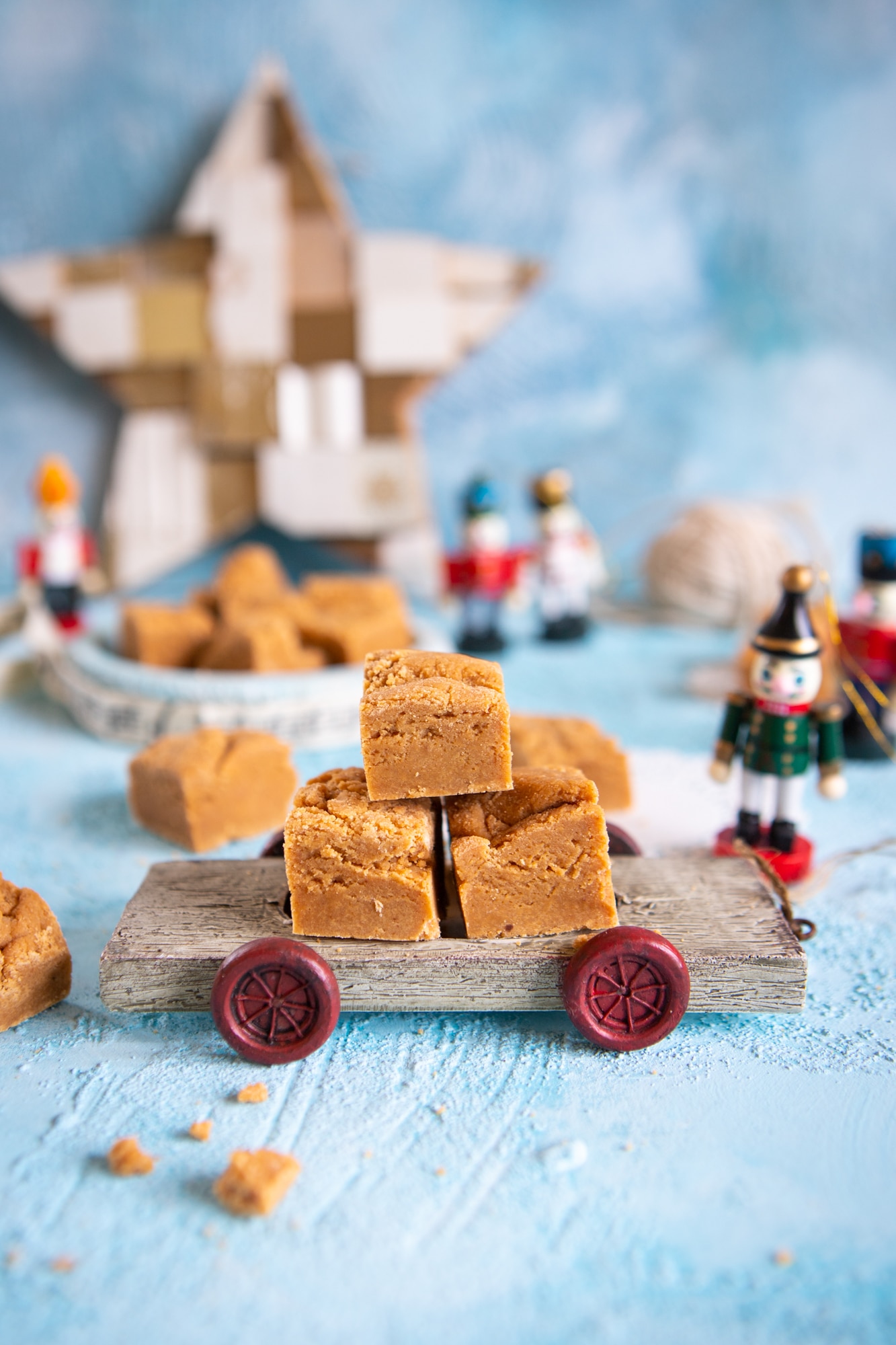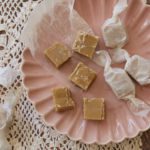
This post may contain affiliate links. Please see my full disclosure for details.
Hi Bold Bakers!
It’s Vedika again! IN THIS RECIPE: This is a classic, incredible fudge. It takes a bit more effort than Gemma’s Microwave Fudge recipe — but the results are worth it. You can find all kinds of tips and troubleshooting in this article, and if you need any extra help, be sure to leave a comment down below! We respond to all comments on the website, and we’ll get back to you shortly!
Many years ago, on a trip to Edinburgh, I found myself in a fudge shop: a kid in a candy store, literally. Shelves and shelves of colorful bitesize pieces, some circle-shaped. Decorated with nuts and drizzles galore. I cannot recall the name of the store now, but I can recall witnessing the birth of fudge firsthand. Syrupy liquid poured atop a work surface, and metal scrapers used to work the fudge into the perfect consistency, and eventually shape.
The texture was firm yet creamy, and very sweet. Now, fudge is a dangerous concoction. A small piece should have sufficed, yet I kept pulling square after square from the bag until it was empty.
When I returned back home, I was keen to reproduce what I had sampled during my trip. But as a self-proclaimed perfectionist, attaining the perfect texture and flavor wasn’t quite as easy as I had hoped, and it took many (many) batches to perfect the recipe.
Fudge is tricky, but it’s not impossible to master once you get the hang of it, and I’m here to share my insight so that you can get your fudge recipe right.
Essential equipment
- Medium-large heavy-duty saucepan: To make this recipe, you need a big, heavy-duty saucepan. The kind with a thick bottom. Why? Well. Fudge is all about boiling sugar for an extended period of time, and a heavy-duty pot prevents the sugar from burning.
- Candy thermometer: Now. You can get around using a candy thermometer using the soft ball test (see below). But as a first-time fudge maker, a candy thermometer helps you get the right temperature so that the fudge will set properly. Too low of a temperature could result in a fudge sauce rather than perfect squares, or a brittle toffee.
- Correct temperature: Make sure your candy thermometer is correctly calibrated and reads the correct temperatures. To check, bring a pot of water to a boil, then place the thermometer in. it should reach 100 C when the water is boiling. If not, then I wouldn’t trust it.
Making Fudge Without A Thermometer
If you want to make homemade fudge, I would recommend investing in a candy thermometer. Because candy-making is rather precise, a thermometer gives you the best, most accurate results. However, if you’d like to try without one, it’s not impossible – you can use the cold-water test. What you’ll need is a glass filled with ice and a little water. Just a nice, cold glass of water that you could see yourself sipping during a hot summer day.
Once the fudge has been boiling for a good amount of time, take a small spoonful and drop a tiny bit of the mixture into the glass. Let it sit for around 30 seconds, then using your fingers, lift it out of the water. It should form a soft, malleable ball between your fingertips. This is the soft-ball stage.
Essential Ingredients

For this fudge, you’ll need brown sugar, sweetened condensed milk, regular whole milk, butter, salt, and vanilla. The salt balances the sweetness of the fudge, you’ll need it!
It’s the holiday season after all! And a little goes a long way.
I love the caramelly flavor of brown sugar, so I use the darkest I can find. Here in the Netherlands, the color is dark brown, almost like chocolate. In the UK, dark muscovado sugar is delicious, In the US, dark brown sugar would work. In Poland, I use demerara sugar. If you don’t have brown sugar, add 3-4 tbsp of molasses to granulated sugar then measure again.
How To Make Salted Caramel Fudge
- Start by preparing and getting everything ready to go (i.e. preparing the tin, and your beaters should be plugged in and prepared).
- You’ll start but putting almost all the ingredients (condensed milk, butter, milk, and sugar) into the pot (minus the vanilla and salt).
- Next, you’ll bring everything to a rolling boil on low, where the fudge will cook for around 13-15 minutes. The mixture will thicken, you’ll see this in the size and variety of bubbles. At this point, you can test the mixture using
- Once your thermometer reaches the softball stage (I stop at 116 C), you’ll turn off the heat.
- You’ll beat the fudge till it’s no longer glossy, then spread it into your prepared tin and let it set. Cut into cubes and enjoy!

Beating The Fudge
This step is key to the texture of the fudge. Not beating it enough might prevent the fudge from setting properly.
In my student kitchen in the Netherlands, I don’t have electric beaters, so I use a whisk or wooden spoon to beat the fudge. This is tricky because it takes longer, and the fudge gets quite firm and becomes difficult to beat. However, electric beaters speed up the process significantly. You’ll want to beat the fudge for 5-10 minutes on low or until it’s very thick (think cookie dough), and has lost its sheen and gloss.
Firm, Melt-In-Your-Mouth Fudge
The longer you beat it, the firmer and crumblier it will be. I like it to be quite firm. Firm fudge is almost like biting into a sugar cube, but creamier, and richer. Texture-wise it’s fairly hard.
As the fudge sets rather quickly, you’ll then need to work fast to get your fudge into the baking tray, so make sure it’s been prepared ahead of time. Spread it out as best you can, then let it sit in the fridge, covered, overnight before cutting into pieces.
The fudge will firm up more as it sets.
Troubleshooting

Here are some of the issues that people usually face when making fudge. I’ve been at all of those stages.
Fudge That Is Too Soft
- This is caused by taking the mixture off the heat too early. You’ll want to let it get to at least 113 C, even longer if you want a firmer fudge (I go for 116 C)
- This is also caused by not beating the fudge long enough
Fudge That Is Too Firm
- You took the fudge off the heat too late
- You beat the fudge too long
With #1 and #2, make sure your candy thermometer is calibrated right. Just to be safe, I use both, the soft ball test and keep an eye on the temperature.
Grainy Fudge
- Your flame was too high, which caused uneven cooking (usually the bottom burns).
- You overcooked the mixture
- You didn’t beat the fudge long enough
- You over-beat the fudge
Follow Vedika Everywhere!
And make sure you get her cookbook, 52 Weeks, 52 Sweets right here!
Get More Holiday Recipes!
- Chewy Sugar Cookies Recipe
- Classic Snowball Cookies
- Chocolate Crinkle Cookies
- Mincemeat
- Mincemeat Christmas Pudding
Have you seen my two new cookie lists? Check out The Top 10 Classic Christmas Cookies and the Top Holiday Cookies of 2021!
Plus, SUBSCRIBE NOW to the Bold Baking Academy for exclusive in-depth baking courses, The Baking Concierge™, and the Bold Baking Academy Community!
Old Fashioned Salted Caramel Fudge Recipe
Ingredients
- 2 ½ cups (16oz/450 g) dark brown sugar, packed
- 1 can (1¼cups/397g/14oz) condensed milk
- ½ cup(4floz/125ml) whole milk
- ½ cup(4oz/115g) butter
- 1 teaspoon vanilla extract
- 1 teaspoon salt (and a little more if you like it salty!)
Instructions
- Begin by preparing your tin. Line an 8x8 inch (20x20 cm) square tin with parchment paper, or grease it with butter, and set it aside.
- In a large heavy-duty saucepan, combine the brown sugar, condensed milk, milk, and butter. Place over medium-low heat, and using a rubber (heatproof) spatula, stir the ingredients till everything is combined, and the sugar has dissolved, and clip on your candy thermometer.
- Over low heat, bring the mixture to a rolling boil (this will take 5-10 min), stirring slowly but constantly. Be careful, the mixture is very, very hot! Let the mixture boil for around 13-15 minutes, stirring slowly but continuously, or until the thermometer reaches (240.8°F) 116°C. Be careful, the mixture is very, very hot!
- This is slightly at the high end of the soft-ball stage (which goes from 235°F to 240°F (113-116°C), but I find it works best for a firm fudge. For a softer, creamier variety, stop between 237°F (114°C) and 115°C (239°F). Keep an eye on the fudge, it will stay at 104°C (220°F) and then rapidly increase after that.
- Along with the candy thermometer, I also do a soft ball test, by dropping a little bit of the mixture into a glass full of icy water. Remove with your fingertips, and if it forms a soft, malleable ball that doesn’t stick to your fingers, you can off the heat. Stir in the vanilla and salt.
- Let the fudge cool to about 43-45°C (110°F), then beat the fudge for 10-15 minutes by hand (using a whisk or wooden spoon), or for several minutes (around 5) with an electric mixer or until the mixture thickens significantly (it should look like soft cookie dough), and it’s lost its gloss and sheen (it should be matte). The longer you beat the fudge, the firmer the fudge will be. You’ll have to try this and see what you like.
- Working quickly, spread the fudge into your prepared tin, as best you can. Score the fudge using a knife, then let the fudge cool. If it’s still too soft, cool for longer. In this case, I prefer overnight (because it sets better the longer you wait).
- Then cut into squares. This keeps for up to two weeks and makes great gifts.






I substituted the sweetened condensed milk with carnation caramel. Turned out fine, and went a beautiful dark-chocolate colour. Mine was slightly gritty and stiffened quickly at the end so I couldn’t stir much (I don’t like crumbly fudge anyway so stirring wasn’t on my mind) but personally I like grainy fudge so it’s not an issue for me. I done mine without a thermometer and it was my first time doing this so it was very hard to judge what was “too much” or “too little”. I had mine on low heat for about 15 minutes then slowly put it… Read more »
I just finished making this recipe and it did not turn out, it’s kinda grainy and could not stir it at the end. I’m curious what I did wrong?
I had to try this one out. Salted caramel? Yes, please. And, despite not quite getting the consistency I wanted (a little too soft, I’ll have to do better the next time) I can’t complain. It tasted phenomenal and was a big hit! Thank you so much for the recipe.
Next thing I’m trying is the 2 ingredient egg noodles, since I can’t seem to find any at the grocery stores around here right now.
I love fudge. This is a different flavor that I have never had. I make a white chocolate Sailor Jerry’s Rum fudge that I made up. My kids love it.